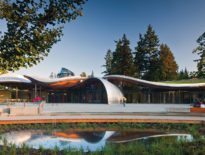We need leaders, a lot of them. And we need these leaders to influence change quickly and effectively. This is not easy, as the changes envisioned in the sustainable building community must occur within complex, layered systems—and of course, they require us humans to work together.
The EMERGE leadership model provides a strategic leadership model specifically designed for the sustainable building community to help do this work. As you can see from the illustration (see graphic), the model consists of three components—Leadership, Change, and Community—and is intended to be a framework for systemic transformation.
Each of the three components is divided into tiers that provide a foundation, centerpiece, and distinction. The foundation is the bottom line, the centerpiece is exactly as it denotes, and the distinction is the “cherry on top.” So, for the Leadership component, for example, the foundational tier is Principled Business Practice (what most MBA programs promote as “good” leadership), the centerpiece is Servant Leadership, and the distinction is Aspirational Leadership. The latter highlights the fact that we do have an agenda—we want to facilitate a thriving, life-sustaining environment for all species through our work.
A thread that runs through the model is the importance of the human connection in leading others effectively. For example, in the leadership component, the centerpiece or core principle is servant leadership, which puts people first, and in particular, is focused on “growing” leadership in those being led. Robert Greenleaf, who coined the term “servant leadership” in 1970, held that the “best test” of servant leadership is “Do those served grow as persons, do they grow while become served, become healthier, wiser, freer, more autonomous, more likely themselves to become servants?”
One of the most important ways that servant leaders effect this growth is through deep listening to those they wish to influence. Servant leader scholars refer to deep listening as ‘listening to the listening.’ For emergent leaders, this means learning what clients, community groups, or colleagues truly care about by listening not just with our ears, but also with our eyes, minds, and hearts.
In the change component, the core principle is systems theory. In her essay “Thinking in Systems,” Donella Meadows advised us to “study the beat” of systems before we disturb them, so we can better leverage the right outcomes. And in the book Switch: How to Change Things When Change is Hard, authors Chip and Dan Heath emphasize that “Any change effort that violates someone’s identity is likely to be doomed to failure.”[1] How do we do this without getting to really know those we’d like to influence positively?
So, in the community component, it naturally follows that the foundational principle, collaboration, emphasizes “discovery” as the initial step of the emergent collaborative process (see graphic). In addition to what is commonly considered discovery (current and historic uses) data gathering includes gaining an understanding of the attitudes and interests of key project stakeholders through connection. The most successful projects I’ve been involved with have incorporated opportunities to connect early on and often about both project details and human concerns at an authentic level. In my book, I relate the story of Art Castle, a client of mine from the building industry, who spent time having coffee and conversation with each member of a task force he was putting together. By the time the first official meeting of the group took place, he had deep knowledge of the interests of each member and had already made some great inroads toward finding the consensus he was seeking. The work product resulting from our discussions was unanimously adopted by all of the four cities involved. It was a great example for me, and I’ve tried to implement it in my own change work.
As the emergent collaborative process continues around the spiral, the next step is to create joyous, learning environments. This is not possible without ensuring a safe container for human connection. True leadership is a we activity. Love (expressed as “caring” in the model), has a clear place in fostering collaboration that advances positive solutions, whether we are thinking about project teams, business structures, or community initiatives. The human connection we’re making with others also sustains us as we lead, and helps us be positive attractors to a restorative vision rather than glum representatives of doom and gloom.
Human beings are wired to connect. Matthew Lieberman, the author of Social, makes the case that our need to connect is as basic as our need for food and water. In an interview with Scientific American, Lieberman shares research that although we naturally switch between analytical thinking and social thinking, the latter seems to be our default: “Whenever we finish doing some kind of non-social thinking, the network for social thinking comes back on like a reflex—almost instantly.”
By fostering this social or human connection, we can contribute to our collective health. In a recent article in Psychology Today, Dr. Robert J. Waldinger notes that “sustained, trusting connections with physicians have enormous diagnostic and therapeutic value.” He shares a story of a patient that avoided back surgery when his primary care physician took the time to learn that he was suffering from depression and marital difficulties. In spite of studies that back up anecdotal evidence like this, Waldinger complains that only a fraction of the billions spent annually on health care supports “listening and reflecting.”
Therapist Noah Rubenstein, based in Olympia, WA, has written on the positive effect of human connection. The research he summarizes studied people who live in walkable neighborhoods, and people involved in church. People who “attend church and build relationships there are consistently happier than those who attend and do not build relationships.” And people who live in walkable neighborhoods are more likely to “meet people, become involved in community volunteer work, build relationships through that work, and ultimately feel happier.”
Human connection enhances our sense of identity and our resilience—both are extremely important in difficult, unstable moments. And we are definitely in an unstable moment. Fortunately, recognition of this reality has gone beyond abstract statements of support. Now, specific actions to foster human connection through our building and community development projects are being incorporated into health and well-being green building certifications.
In Teachings on Love, Thich Nhat Hanh encourages environmental activists to find a Sangha (or support community). “Without a Sangha, you will not have enough support, and you will burn out very soon.”[2] Understanding and utilizing the human connection helps us do our work effectively, and helps us stay engaged with the work. Next time you begin a project, your first question should be, “How might we find and build on the natural, human connection in this project, with these people, at this time?” It will change everything.
ILFI will be offering an EMERGE Leadership workshop at the Living Future unConference on May 1 in Portland, OR. Separate registration required, sign up here.
[1] Crown Business, 2010
[2] p. 138




